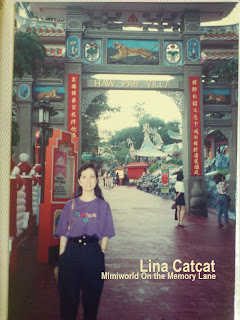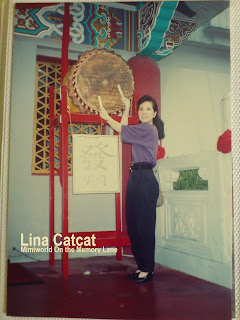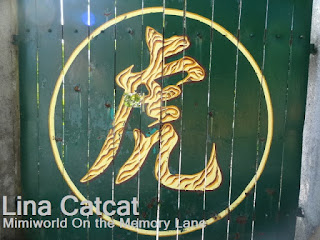Kusu Pilgrimage
I have been to Kusu island (Tortoise island) to pay homage to both Chinese temple and three Malay Keramats for decades when I was a teenager back then. My mum with her siblings and her old friends went to Kusu island to pay homage to a Chinese temple and a Malay Shrine and they have been going there more than 4 decades till present. You may read my blog here and it's been 6 years that I blogged.
To A Kusu Island temple 龟屿大伯公
Every year for the month of September to October which falls on ninth month of Chinese calendar, for a long month for the local residents, visitors and tourists alike visit to a Kusu Island. This year, the time has come, Kusu Pilgrimage season which falls on the 13th October 2015 to 11th November 2015 for a month long. Devotees (Taoists and Buddhists) visit to the Kusu Pilgrimage to pay homage to Tua Pek Kong temple (also known as Da Bo Gong), a Merchant God, Guan Yin (Goddess of Mercy) and there are other side altars to the Sun Wukong (the Monkey God) and other deities. You may expect a parking crunch and boarding delays at Marina South Pier for other Southern Island destinations during this traditional season. And the regular ferry to St. John's Island will be suspended during this period.
Da Bo Gong (大伯公)Temple in 2013
On the 19th October 2015, my family and I went to Kusu Pilgrimage in the early morning on weekday as there are not much crowded at that time. It's better to go in the morning and you still have time to stroll along the beach area, wishing well (tortoise shelter) sanctuary I heard their folklores stories from older generations.On Kusu Island, devotees and visitors should NOT bring any porks or meats into the temple as it is traditional and culture for the Chinese temples and Malay Shrines. We also should not consume any meats or porks for two days before set off to the Kusu Pilgrimage. Thus we ate vegetarian foods for two days.
Photo 2015: Water dried up
This time, I see the water dried up on the hot weather compared to last year or in 2009. I wonder where is the caretaker that take in charge of the Sluice gate that release waters from the sea water? The Chinese temple is covered by haze in the morning but we still went on to pray at the temple.
Kids seen praying
Young parents would bring their kids to a Tua Pek Gong temple to pray for good results in their study, nowadays young obedient kids are guided by their parents on how to hold with 'Joss sticks" to pray. This is good example of upbringing for kids to grow up when they turn into adults in the near future.
blessings. Notice the "Cartoon" God Of Wealth Cai Shen Ye 财神爷 is placed on the prayer table as we don't see it last year or so. I think the caretaker wants to display it on the table as there is no need to do so and it could occupy with no space for incense papers and fruits placed on the table. Surprising! I remember the God Of Wealth is placed at the Guan Yin on the right side at the corner end.
Devotee placed some fruits on the table
Devotees bought incense papers, joss-stick and brought some fruits, placed on the table for blessings. Notice the "Cartoon" God Of Wealth Cai Shen Ye 财神爷 is placed on the prayer table as we don't see it last year or so. I think the caretaker wants to display it on the table as there is no need to do so and it could occupy with no space for incense papers and fruits placed on the table. Surprising! I remember the God Of Wealth is placed at the Guan Yin on the right side at the corner end.
Tua Pek Gong and Guan Yin
On the left is Tua Pek Gong and Guan Yin 观音 (Goddess of Mercy) is on the right shown in this photo above. Built in 1923 by a wealthy businessman, the temple houses two main deities - the Da Bo Gong and Guan Yin 观音 (Goddess of Mercy). It is highly regarded as having the power to confer prosperity, cure diseases, calm the sea and avert danger, while Guan Yin is also known as the 'giver of sons' to the childless couple.
Wishing Tree in 2013
There is a wishing tree locates next to other deities where devotees placed wishing message on the tree or throw it higher to the tree as they believed it will bring good luck to their business and health & harmony to the family.
Kusu - Tortoise Island in 2013
History on Kusu IslandKusu in Chinese mean "Tortoise Island". Legend has it that a tortoise had turned itself into an island to save two shipwrecked sailors. Tortoise are known to live to a ripe old age. Many believe touching tortoises can bring good fortunes and longevity.
Newly renovated at the pond
Turtle Pond
Happy to see the newly renovated of the Turtle/Tortoise pond with coated in red paint and lively tortoises swimming gracefully in the pond located beside Tua Pek Gong temple.
Photo 2013: Turtle Pond at Malay Shrine
2013 Close up: Tortoise on the stones
A small pond painted in yellow located at the Malay Shrines where turtles/tortoises swimming and it was a sorry sight. A tortoise was landed on the stones with no water under the sunny weather.
Legends of Datok Syed Abdul Rahman
Legends of KusuSeries of legends stories were told from Singapore many centuries ago:
A) Most Favourite Stories from Singapore, by Monteiro and Watson recounts how 150 years ago, two holy men named Dato Syed Abdul Rahman, an Arab and Yam, a Chinese man made a meditation and fasting trip to Kusu. In the course of this pious mission he fell ill and Syed Rahman prayed fervently for him. Through the intervention of supernatural forces, food and water were provided on the island from the passing boat and thus saved their lives. Syed and Yam later became sworn brothers.
B) Sailors shipwrecked in the waters near Singapore during one Lunar Ninth month centuries ago were also rescued by a giant turtle (tortoise) which turned itself into an island.
C) More than a hundred years ago, an Arab named Syed Abdul Rahman left Singapore in search of peace with his wife and daughter. While they were in a sampan they were caught in the violent storm which capsized their sampan. A giant tortoise spotted them and brought them safety to an island. Legends also has it that their lost sampan not only returned but was loaded with food.
D) Centuries ago, passengers on board a ship were stricken by an epidemic but all recovered as soon as it dropped anchor near the island.
152 Steps to Malay Shrine (Keramat)
After pray to a temple, we proceed to a Malay Keramat (Shrine) located on top of the hill and we walked up the 152 steps to reach "Datok Kong" shrine that comprises three keramats - Datok Syed Abdul Rahman, Nenek Ghalib (mother) and Puteri Fatimah (daughter), who had lived around the time of Stamford Raffles in the early 19th century.
Huat Ah! Huat Ah!
Some devotees pray to Datok Nenek and daughter Fatimah for blessings and yellow strings (tight round the wrist) chanting by Malay caretaker for good luck. Each devotees has a yellow string being prayed on the burner
Blessing notes inscribed pasted on the wall
Some devotees would pray for good luck, good wealth, good business, good marriage and so on. Blessing notes is inscribed and pasted on the wall of the Datok Nenek Ghalib (mother) and Sharifah Fatimah (daughter).Although there are Muslim symbols around this shrine - the star and crescent moon being the most obvious - the prayer ritual was rather "unusual". Devotees could "tiam yew" just like in the Taoist temples - i.e. for a small donation, the Malay caretaker would add oil to the lamps, ring a bell and chant some auspicious sayings before the keramat. Chinese joss-sticks were used apart from having the "kemayan" (incense) lighted before the deities.
Food Centre
Food Centre is situated on the bottom of Malay Shrines and the gift stalls close by.
Fried Kuey Teow (Char Kuey Teow with cockles)
Fried Oysters with eggs
The stalls sell different varieties of foods and drinks stalls as well as coconut juice, most famous foods like Char Kuey Teow, fried oysters with eggs and laksa are my favourite foods, my aunties and my family love it. Coconut is one of my favourite in early years and but now I have to skip it. By drinking coconut juice in its shell would taste sweet. Looks yummy!
Coconuts
The coconuts used for drinking are “young” or “green” coconuts, not the mature brown, hairy ones you see in the grocery store. Young coconuts are six to nine months old. A fully ripened coconut will take 12 months to mature. These are the ones sold in grocery stores and wet markets. These ones (above) are supplied from the mainland in Singapore. The water in the young coconut is generally much sweeter and better tasting. The water in mature coconuts is often bland and sometimes even slightly sour. Well, this time, I skipped drinking it and last year I had drank it.
Facing the sea from where I sat
Rows of foodstalls
It was indeed a huge tent and the foodstalls lined up side by side, sell varieties of good foods and there's a white board written on the each food & price on it for the visitors to take note what they have in store before ordering.
Photo 2012: Stalls selling gifts items
I bought one item - Fan shape (Hello Kitty) while my mum got traditional fan shape and my auntie bought three small Chinese bells with a red string from the stalls, walked over to the Tortoise Sanctuary nearby.
Tortoise Sanctuary
My auntie threw coins into the caged well
Every devotees and visitors would visit the Tortoise Sanctuary after their prayer and they throw their coins ranging from 10 cents to a dollar coin into the hole in the well. Some devotees also threw coins into the Wishing well at the shelter on the other side of the temple.
Photo taken in 2013: Fishing
As I strolled along the island and I remembered that there was a man who stood close to the sea and the signage was seen beside him. Many people who love fishing, would bring their fishing rods and walk to the edge of the rock to fish. No swim is allowed close to the strong current spot.
Heading home
After 3.5 hours or so, it's time for us to head back to the boat jetty port and the sun is getting hotter in no time.
heading to Jetty port
Upon reaching the boat jetty, I noticed that we would head to the right side from where we came earlier instead to the left side.
Photo 2012: On the way to boat jetty
The boatman said that the boat sometimes arrives on both side and it couldn't be any problem to where we go back to the same location in the first place. Up to last year in 2014, we went to Kusu Island and was on the left side of boat jetty.Now we were heading to the right side of the boat jetty (above).
Boat Jetty on the right
Reaching to the boat jetty on the right as above as the boat is about to leave soon, as there is no need to be waiting at the shelter as the boat is already packed with devotees and visitors earlier and there are some empty seat available otherwise we missed it. We have to wait another incoming boat for another 15 minutes.
Huts or Restrooms
Before we leave, there are huts or restrooms stationed on each side for the visitors to rest and there is a toilet at the bottom of the hillock of Malay shrines. Did you see the four flag poles with inscribed "Sentosa" printed?
Goodbye Kusu Island
It was indeed a short visiting to the Kusu Pilgrimage every year and we will come again next year. It is indeed a warm and peace on the island.










































































